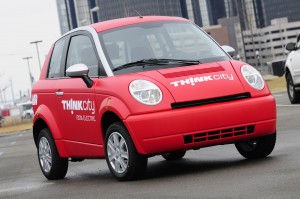By John Addison (8/9/10)
I drove the Think City EV on San Jose’s streets. The U.S. vehicle is a 2 seat, 2-door hatchback. Think got adequate acceleration on city streets, even in its range extending Eco mode. My brief test drive did not include steep hills or entering a freeway. Acceleration did not come close to my Mitsubishi iMiEV test drive; on a freeway, I would have acceleration concerns.
Even though Think has no power steering, it is easy to navigate. Not ready for prime time, the prototype car that I drove rattled.
When Think targets consumers in 2012, it will need to price well below the Nissan Leaf’s $32,780 price, to be successful. With U.S. consumers, the utilitarian 2-seat Think will compete with larger sedans such as the Leaf, and smaller electric cars with more sex appeal from Toyota, Honda, Mitsubishi and Smart.
Think started pioneering electric vehicles 19 years ago. It’s been owned and dropped by Ford; in and out of bankruptcy. The new Think has big ambitions and big backers, such as U.S. venture capital giant KPBC, Valmet and EnerDel. The new Think EV for the U.S. market will be built in Indiana. The electric car’s 22kWh lithium battery is built in Indiana by EnerDel. Other new suppliers are now being selected for the U.S. built car that will be somewhat different than the European version.
Think could do well with the U.S. fleets that already use some 20,000 light-electric vehicles (LEV), like the 25 mph Chrysler GEM, to shuttle people, cargo, and maintenance people with their equipment. Millions of LEVs are in use globally. University and corporate campuses are popular places for these LEVs. Much bigger than an LEV, the Think City EV is almost 123 inches long, weighs about 2,300 pounds, and has more cargo space than competitive battery-electric micro and sub-compacts.
Upgrading these LEV fleets may be a significant opportunity for THINK. These LEVs typically max out at 25 mph, and only have a 25 mile electric range. The Think EV’s larger size, highway speed, and 100 mile range would be ideal for many applications. Fleets sometimes have trouble getting old equipment off the books. A trade-in program would appeal.
Think already has 1,700 of its new generation EVs on the road in northern Europe. The Think EV has done well with municipal and commercial fleets there. In Brazil, major electrical equipment supplier CPFL recently purchased 3 Think EVs. As Think prepares for U.S. manufacturing, it is in discussions with a number of U.S. fleets.

